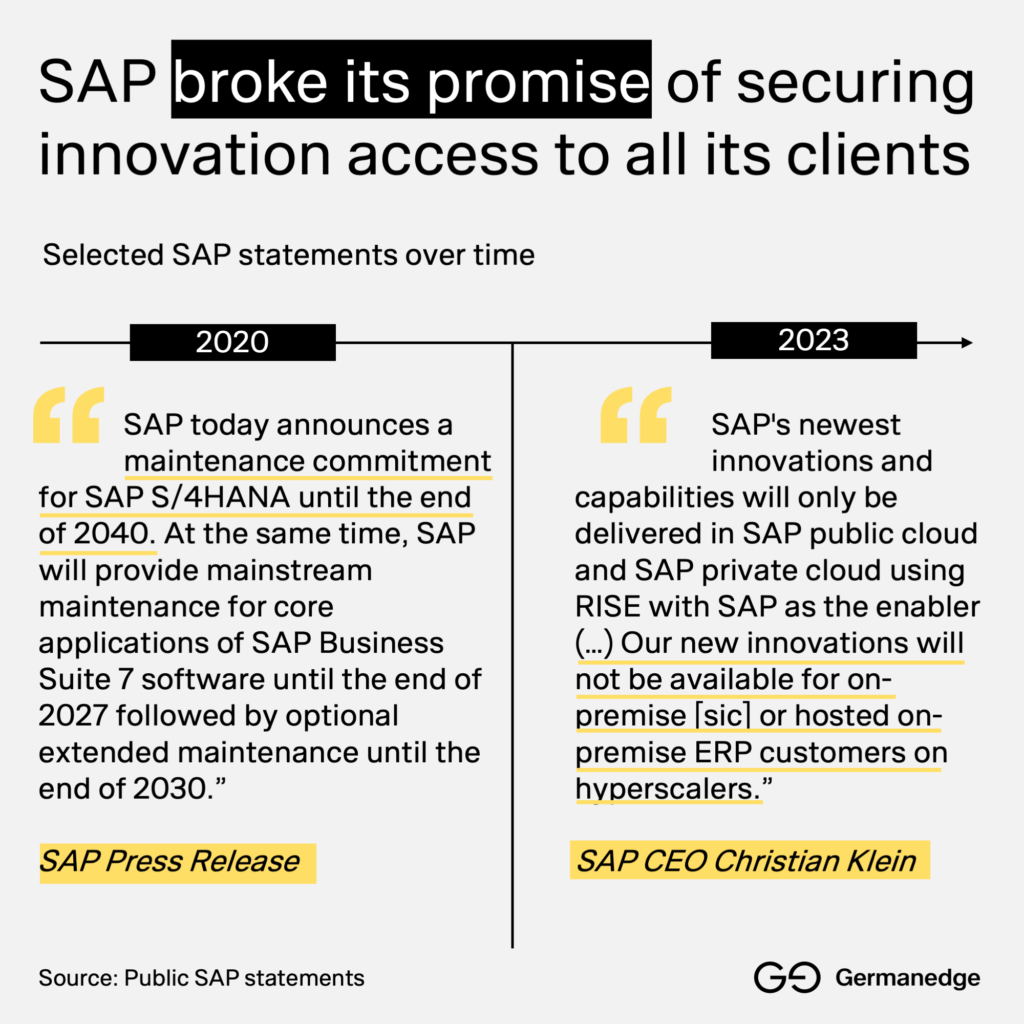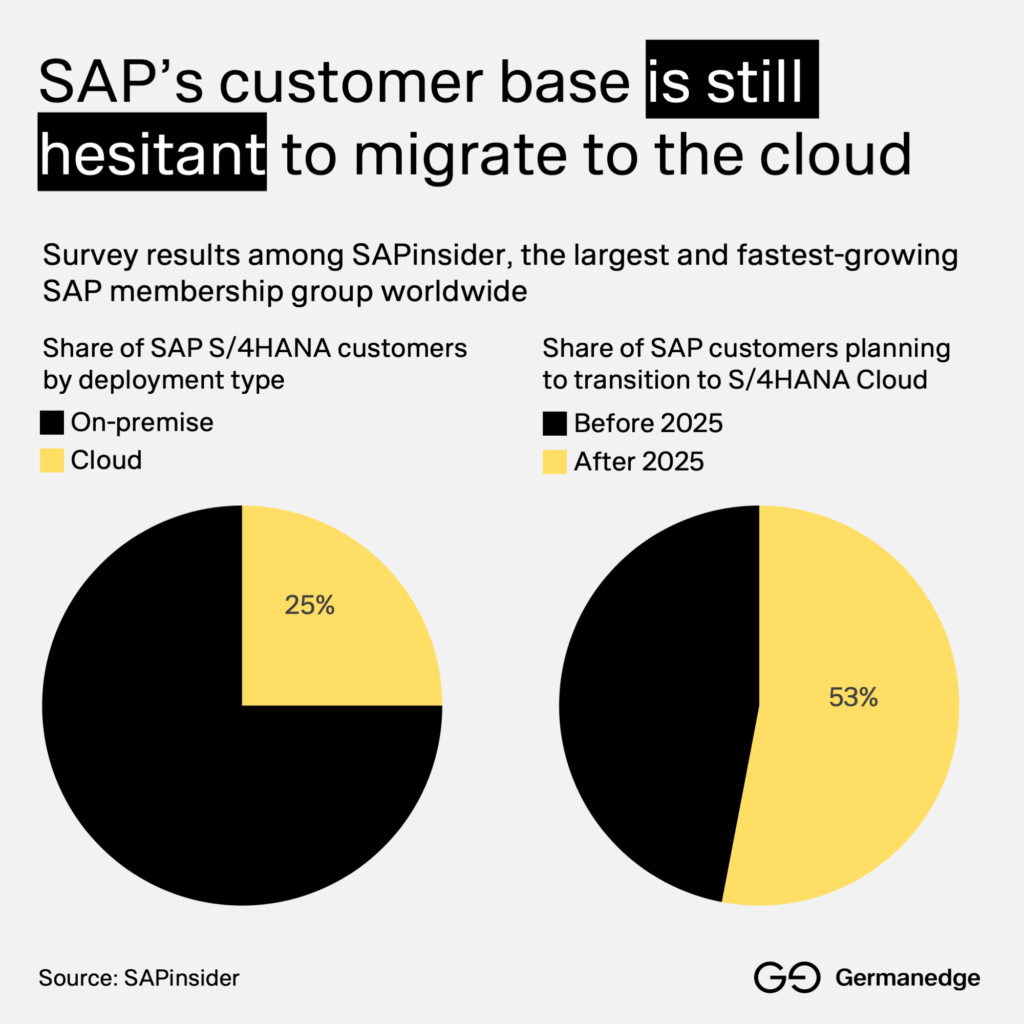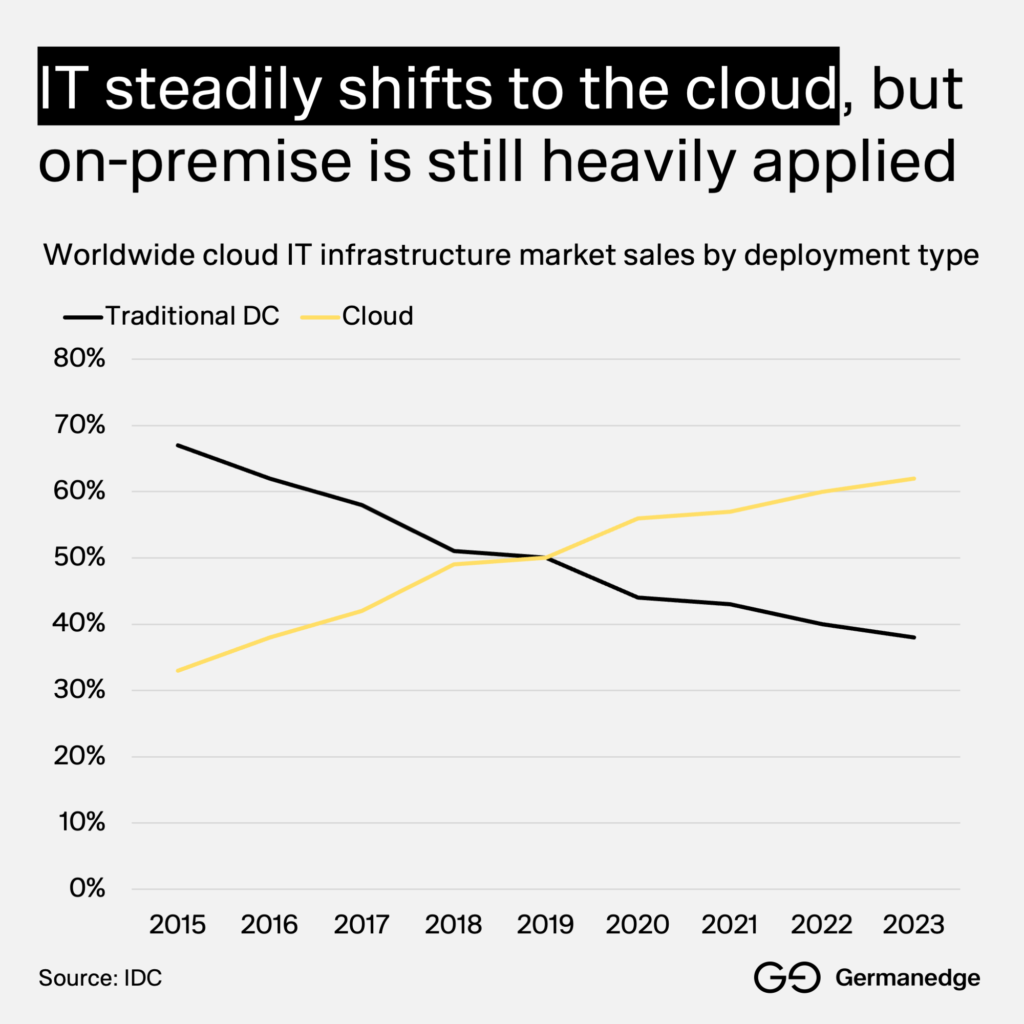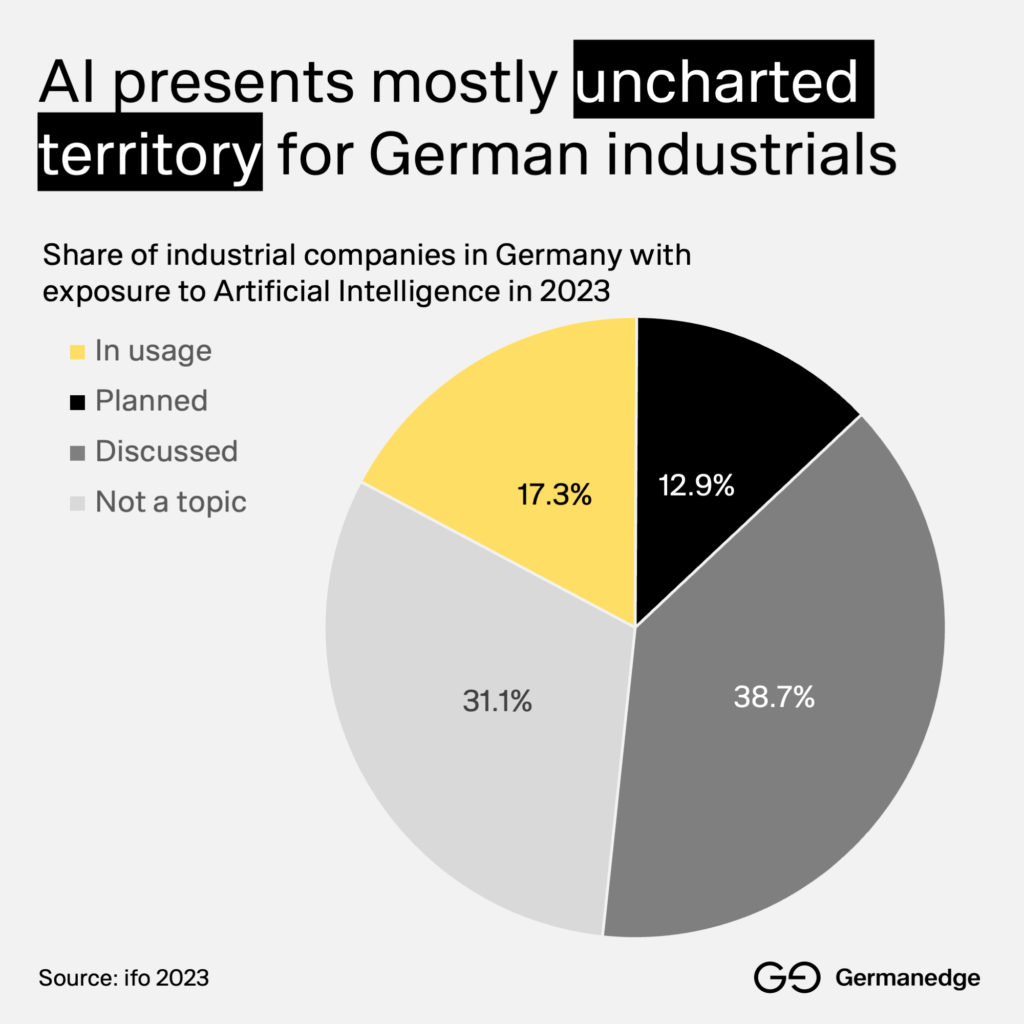The recent announcement from SAP during its Q2 2023 quarterly reporting has sent shockwaves across the industrial sector, especially in German-speaking markets.
In late July, Christian Klein, SAP’s Chief Executive Officer, revealed that future SAP innovations would be exclusively cloud-based, pivoting away from prior commitments.
This was surprising, to frame it politely, especially given SAP’s earlier promises. For years, SAP pledged not to tether enhancements exclusively to the cloud. Previous commitments for its S/4HANA solution were for all customers, not just those in the cloud.
With this new change in direction, SAP has effectively downgraded a segment of its loyal customer base to second-class status—German service mentality at its finest!

The implications of this announcement–particularly for businesses that had invested heavily in migrating to the latest S/4HANA ERP platform on-premises–are seismic.
Trust is crucial in tech partnerships. It’s built over years, yet can be shattered instantly. The strong reactions from UK and German user groups are a testament to this.
“SAP is leaving numerous loyal customer companies in the lurch,” DSAG openly concludes.
From where I stand, as the CEO of Germanedge, and with a keen understanding of the industrial clientele’s diverse needs, SAP’s move, indeed, feels like a betrayal, stemming from sheer arrogance and a blatant disregard for its loyal customers.
Those who have relied on on-premise solutions, such as S/4HANA, now face an uncertain future. They can still expect functional updates, but major innovations, especially in areas like AI and sustainability, are now out of bounds.
Furthermore, the only clear path forward that SAP presents is a shift to their proprietary cloud. This move not only sidelines other major cloud providers like AWS but also puts businesses in a precarious position. By transitioning to the SAP cloud, companies essentially put all of their digital infrastructure eggs into a single basket owned and controlled by SAP.
While “locking in” clients into their cloud ecosystem might be a logical move from SAP’s standpoint, the reality for clients is a burgeoning dependency on a single provider. This inherently curtails competition and can have long-standing implications. As history has shown, limited competition often paves the way for price inflation. With businesses tied closely to SAP’s ecosystem and fewer alternatives at their disposal, they might find themselves with dwindling bargaining power. Over the long term, this could lead to SAP exerting greater control over pricing, potentially forcing clients to bear the brunt of cost increases.
Though SAP has since countered with the rhetoric of cloud solutions being indispensable for churning out innovations at today’s required pace and flexibility, the hidden costs are hard to swallow. On-premise customers now find themselves cornered, grappling with the prospect of shelling out additional costs for the SAP Business Technology Platform (BTP), over and above their existing maintenance fees.
But the ripple effects of this decision, I believe, extend far beyond the immediate uproar.
Let’s delve deeper into two main reasons that magnify the repercussions of SAP’s cloud-only strategy.
SAP is Bullying its Own Customer Backbone
SAP’s embrace of the cloud has, undoubtedly, been commercially successful thus far. Its S/4HANA Cloud product witnessed a nearly 100% revenue growth to €2.08 billion in 2022. The technology giant is, without a doubt, surfing the current wave of IT infrastructure migration to the cloud.
However, a closer look at the numbers paints a different picture of SAP’s customer landscape.
Of the businesses that have deployed SAP’s S/4HANA, only about a quarter seem to be basking in the cloud version, according to SAPinsider. This startling statistic translates into a clear message: SAP has chosen to channel critical innovation solely to a minority of its current clientele, sidelining the overwhelming majority.
Is the term “bullying” too strong for such a strategy?
Not when you consider the broader implications.
Customers are being cornered into making a shift that many neither desire nor find operationally feasible at this point. According to SAPinsider’s 2023 Deployment Approaches to SAP S/4HANA report, over half of the respondents have no plans to transition to SAP S/4HANA before 2025.
Even more striking, a quarter of them envision this move post-2027.

With this being said, the world is undoubtedly moving to the cloud, but it’s essential to read the tempo of this transition accurately.
Global data from IDC backs up this sentiment, revealing that more than 35% of global IT spending is still rooted in on-premise solutions in 2023.

The cloud undoubtedly promises a transformative future, but the shift needs to be organic and in sync with market dynamics.
As much as I understand the allure of the cloud’s potential for the next decade, bulldozing customers towards solutions they are not intrinsically ready for is not the answer.
Furthermore, customer reluctance to transition isn’t merely a case of change aversion. Businesses have legitimate concerns. The hurdles are manifold, from grappling with the intricacies of their existing SAP setups to the sheer duration such projects demand. Moreover, many are yet to be convinced of the unique value proposition of SAP S/4HANA.
In essence, while it’s one thing to lead market evolution, it’s entirely another to force it, neglecting the realities and preferences of the very clients that form your backbone.
SAP’s Cloud Push Risks Amplifying Germany’s AI Deficit
There is another major risk in preventing the majority of its client base from accessing innovations.
By forcing delayed access to new product innovations, especially vital AI tools due to cloud migration timelines, SAP is unintentionally placing its clients, predominantly S/4HANA on-premise users, in a dangerous position where they risk missing out on pivotal AI advancements.
This is particularly painful for SAP’s German clients. Drawing from my previous writings on Germany’s Digital Lag, it’s evident that the nation’s industrial sector is grappling with the digital strides of Industry 4.0. The urgency of AI integration for German companies can’t be overstated. According to recent ifo survey data, a mere 17% of German industrial firms are harnessing the transformative power of AI thus far.

With these stats in mind, withholding access to groundbreaking AI capabilities for businesses, especially during such a pivotal era, not only hinders their competitive edge but can also curtail Germany’s momentum in the global digitalization race.
In this high-stakes game of technological advancement, the objective should be straightforward: facilitate, not obstruct.
While I’m by no means denying the imminent cloud trajectory of the future, the timeline and approach matter. SAP’s strategy of restricting avant-garde AI tools to its cloud realm, and by extension, to a minority of its user base, is a gamble. This is one that could echo ramifications not just for its immediate clientele, but potentially for the broader industrial tapestry of a nation like Germany.
While steering the market towards a promising cloud horizon is commendable, sidelining a significant portion of your clientele and compromising their AI prowess is just a bridge too far.
Embracing the Cloud Journey, Not Imposing On It
As Germany’s industrial sector stands in the middle of the Fourth Industrial Revolution, the need for agile and flexible supply chain and production systems has never been more apparent. This need for speed and agility is particularly mission-critical for manufacturing and industrial companies that stand at the heart of value creation. Encouraging clients to adopt the cloud, therefore, is in the interest of all. However, the urgency to adapt shouldn’t equate to strong-arming businesses into this new future.
SAP’s current trajectory, by forcing a cloud-centric paradigm, is notably executed at the expense of its trusting clientele. Such an approach not only undermines the very ethos of customer service but directly clashes with the foundational principles upon which the tech-service industry was built: understanding, collaboration, and partnership.
Each organization stands at a unique juncture in its digital transformation journey. While it’s indisputable that the horizon belongs to cloud-heavy planning systems, the timeline for reaching that destination varies from one company to another. It’s vital to recognize and respect this diversity.
When a technological giant like SAP makes the unilateral decision to set the clock on behalf of its customers, it’s not just an overreach—it’s a glaring disregard for the ownership of business operations and the trust placed in them. Such a strategy doesn’t simplify lives—it complicates them.
A Different Cloud Approach Respecting The Customer
At Germanedge, our outlook on this digital transformation is fundamentally different.
While we are unwavering advocates for the cloud’s future, our commitment is, first and foremost, to our customers—particularly the small and medium-sized businesses that form the backbone of the German economy.
As a result, our cloud strategy is fundamentally rooted in open standards. We proudly offer a portfolio of solutions with a broad range of FOSS services based on individual client needs. This approach not only ensures flexibility for our clients, allowing them to operate across on-premise, hybrid, and public cloud configurations—including mixed setups—but also promotes continuous innovation.
Our open standards approach doesn’t just allow, but actively encourages the integration of third-party services, breaking down silos and fostering a truly interconnected digital landscape across different providers.
Beyond this, we’ve taken a solemn pledge: never to impose a cloud migration upon our clients.
Our commitment is to offer state-of-the-art innovations to every client, whether they operate on-premise or in the cloud. This promise extends further: We ensure that our customers, irrespective of their chosen deployment model, have seamless access to the latest advancements, all while honoring their readiness and pace for transformation.
In our eyes, this is the hallmark of a true partnership. One has to wonder if, somewhere along the way, SAP lost sight of its foundational role as a genuine technology ally.
